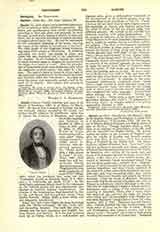

Canute (or CNUT: THE GREAT, THE MIGHTY), King of the English, Danes, and Norwegians, b. about 994; d. at Shaftesbury, November 12, 1035. He was the son of Sweyn, King of Denmark, and Sigrid, widow of Eric of Sweden. Though baptized while a child, there is no evidence of Christianity in his life until after he ascended the English throne. He accompanied his father on the invasion of England, and after the repulse at London and Sweyn’s sudden death near Bury (February 3, 1014) was declared King of England by the Danish fleet. The witan, however, recalled Aethelred, their “born lord”, who had fled at Sweyn’s approach, and Canute, unable to withstand the restored monarch, set sail for the North. At Sandwich, after cutting off the noses, ears, and hands of the hostages taken by his father, he put them ashore—a dire omen of a more terrible return. Returned to Denmark, Canute proclaimed himself king and set about gathering a powerful fleet. England, instead of being prepared for his return, was torn by internal dissensions, and when Canute appeared off the coast with a fleet, said to have numbered two hundred sail, each boat containing eighty men, Eadric deserted Eadmund Ironside and joined the Danish standard. Upon the death of Aethelred, Eadmund was made king by the people of London, and, with all Wessex in submission, Canute laid siege to the city. This was the beginning of a series of bloody conflicts, interrupted only by pillage of the countryside, culminating at Assandun, where, after a battle which was waged all day and into the night, the English were routed, and “all the nobility of the English race was there destroyed” (Anglo-Saxon Chron., ed. Giles, London, 1847, p. 409). Eadmund was still formidable. Canute followed him into Gloucestershire and made terms of peace on the Isle of Olney. Mercia and Northumbria were Canute’s portion, and a tax known as the “danegeld” was levied on both armies to defray the expenses of the Danish fleet. Eadmund died a month later after a heroic reign of seven months; Eadric was murdered at the king’s order; Eadwig, Eadmund’s brother was similarly removed; and in July, 1017, Canute married Aelfgifu, or Emma, Eadmund’s widow, a strange union which some writers attribute to political motives. Canute already had two sons, Harold and Sweyn, by another wife, but the right of succession was to be with the offspring of the new union.
Thus at the age of twenty-three, by right of might, Canute stood master of the realm; and if he was received unanimously by the people, it was because none durst oppose him. From this forward, however, his one desire seemed to be to wipe out the memory of the bloodshed and horror in which his kingship had been secured. The Danish host, a fruitful source of animosity, was dismissed after a danegeld of £72,000 had been raised, London alone contributing £ 15,000. Canute retained the crews of forty ships as a body-guard, known as the huscarls or thingmanna. “Eadgar’s Law“, the old constitution of the realm, was revived and Dane and Englishman stood on a level footing. The Church had suffered heavily at Canute’s hands, but he sought her friendship and built a church at Assandun to commemorate the victory; rebuilt the church of St. Eadmund at Bury and, established the monks there; and was a benefactor in many other places, contributing even to the erection of the cathedral of Chartres. On his visits to Denmark he took many missionaries with him, among whom were Ranier, Bernhard, and Gerbrand, Bishops of Fionia, Sconen, and Zealand. In 1026 Canute made a pilgrimage to Rome, his path being marked by his charities. He records in a letter his joy at visiting the tombs of the Apostles; his meeting with Pope John and Emperor Conrad; his plea for security for English and Danish travellers to Rome; the pope’s promise to lighten the tax for the pallium; and he adds his own vow to rule justly and regrets the misdeeds of his youth.
Canute’s greatest gift to his people was peace, says Green. Eighteen years unbroken by domestic strife laid the foundations of a national tranquility. The kingdom was divided into four earldoms, and little by little Danish names disappear and are replaced by English (Freeman, Norman Conquest, I, 289). The people are to “love and worship one God and love King Cnut with right truthfulness”. The ferocity which mutilated the hostages was not burnt out, for the king struck down one of his huscarls with his own hand. But he pronounced heavy sentence upon his deed and, on another occasion, is said to have rebuked his flatterers by placing his crown upon the crucifix of the cathedral of Winchester. From the time his scepter is secure, a sincere zeal for his people’s good shines out in his life. The yoke is lightened and his benefactions are widespread. He is a patron of poets and a lover of minstrelsy, and upon hearing the monks of Ely chant on Candlemas, he breaks out into the famous song:
Merle sungen de muneches binnen Ely,
Da Cnut Ching reu der by;
Rowed, Cnihtes, noer de land,
And here we pes muneches saeng.
(Merrily sang the monks of Ely when Cnut King rowed by. Row, boatmen, near the land, and hear we these monks sing.)—Intriguing, ambitious, and violent, Canute yet atoned for his early cruelty by a Christianity that was not unworthy. He came as an invader and ruthless destroyer, and by a change of temperament as remarkable as it was far-reaching in its effects, remained to rule, in justice and peace, a people whose part he wholly espoused. He was buried m the old minter at Winchester.
E. F. SAXTON

